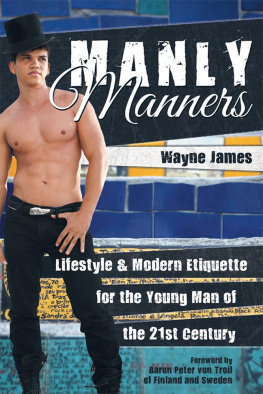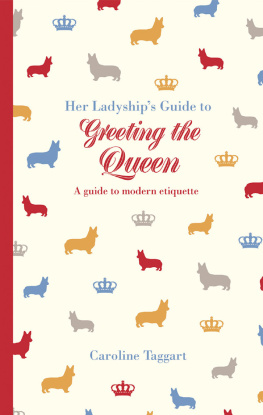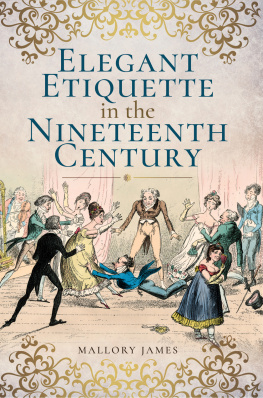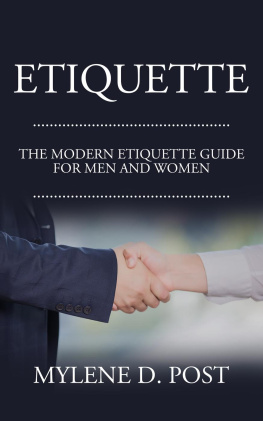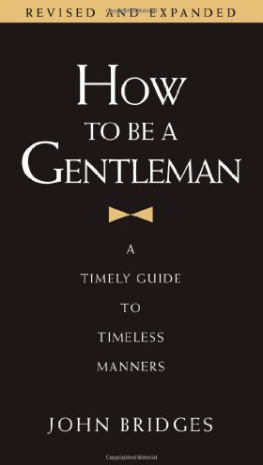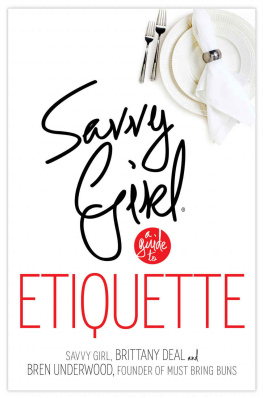MANLY
Manners
Lifestyle & Modern Etiquette
for the Young Man of the
21st Century
Wayne James

M ANLY MANNERS
LIFESTYLE & MODERN ETIQUETTE FOR THE YOUNG MAN OF THE 21ST CENTURY
Copyright 2016 Wayne James.
All rights reserved. No part of this book may be used or reproduced by any means, graphic, electronic, or mechanical, including photocopying, recording, taping or by any information storage retrieval system without the written permission of the author except in the case of brief quotations embodied in critical articles and reviews.
iUniverse
1663 Liberty Drive
Bloomington, IN 47403
www.iuniverse.com
1-800-Authors (1-800-288-4677)
Because of the dynamic nature of the Internet, any web addresses or links contained in this book may have changed since publication and may no longer be valid. The views expressed in this work are solely those of the author and do not necessarily reflect the views of the publisher, and the publisher hereby disclaims any responsibility for them.
Any people depicted in stock imagery provided by Thinkstock are models, and such images are being used for illustrative purposes only.
Certain stock imagery Thinkstock.
ISBN: 978-1-4917-9425-8 (sc)
ISBN: 978-1-4917-9427-2 (hc)
ISBN: 978-1-4917-9426-5 (e)
Library of Congress Control Number: 2016908166
iUniverse rev. date: 11/18/2016
Contents
List of Illustrations:
- Front Cover: Photographer, Daniel Lbo; Model, Jhones Jhony Olyver de Oliveira Nascimento; Location, Selarn Steps, Rio de Janeiro, Brazil.
- Back Cover: Photographer, Daniel Lbo; Model, Guilherme Felix da Rocha; Location, Casa Momus Restaurant, Rio de Janeiro, Brazil.
Chapter-Title Illustrations:
Leonardo Julian Rossi. With nothing but a sheet of paper, a glass of Tuscan red wine, and his fingertip, Italian-born, Berlin-based, German-Italian painter Leonardo Julian Rossi, already being touted The Next Great One, rapidly and effortless renders his wine-on-paper paintingsoftentimes as sketches or studies for his full-scale works in oil on canvasin genres ranging from portraits to still lifes to landscapes.
Diagrams:
- The Wayne James Continuum of Human Sexuality
- The Deconstruction of the Wayne James Continuum of Human Sexuality
- Various Serving-Utensils
- Various Eating-Utensils
- Informal Place-Settings
- Formal Place-Settings
- Various Drinking-Glasses
- Placement of Utensils at the End of the Course or Meal
Graphic Artists:
To my dear father, Gustav Alexander James, Sr., (1919-1983),
who taught me, by example, how to be gentle, then how to be a gentle man, and, finally,
how to be a gentleman.
To my dear friend, Theodor Wundt Krauss (1961-2000),
who confirmed, in his every word and action, my long-held belief that gentlemen still exist
and that there remains a place for them in this unabashedly modern world.
To my dear friend, Lisa Marie Galiber (1960-2011),
with whom, from the day we first met as children, I practiced so many of the things I attempt to teach through this three-volume treatise.
To my dear friend, Charlotte Christine Sybille von Lilienfeld-Kechtel (1962-2012),
who came into my life like a whirlwind but left like a whisper,
reminding me to always nurture my friendships.
To my dear friend, Dr. Hans Gran Lindblad (1952-2014),
for a life dedicated to making the world a better place,
one kind act at a time.
To my dear friend, Florian Gregor Schmidt (1996-2016),
who, in his short time on this Earth, embraced more people, kissed more people, and showed more love
than most other people do in their threescore and ten.
~~~~~~~~~~~
Sometimes the Universe speaks in plain Englisheven if with a Trinidadian accent. Such was the case when, completely out of context, came out the mouth of my dear friend Maria deLarosa in December of 2010: Wayne, why dont you fly to Europe and spread your wings there for a while. And while there, you should write a book. So a few days later, upon the advice of the Universe, via Maria, I packed a couple of leather suitcases with only the essentials and set off for Europeafter visiting New York and Rio de Janeiro, of course. And almost six years laterand nearly six pounds heavier (on account of consuming lots of excellent wine and cheese)the completed manuscript of the Manly Manners trilogy was delivered for publication. So to Maria and the Universe, a heartfelt thank-you!
The impetus for writing the very first words of the very first chapter of the very first volume came in February of 2011 when my friend Francisco Soares de Sousa Neto, upon seeing my notes and outline, exclaimed: Wayne, you should begin writing your book today! My generation needs your book now! It was that very afternoon, after Netto (as he spells his nickname) and I had lunch at Fasano in Ipanema, that I began writing what would become this three-volume work.
With one chapter under my belt, and the second well on its way, I set off for Italyafter a brief visit at Harlemshire Abbey in Manhattan, where I sat with my childhood friend, Carmella Richards, and discussed the scope and bent of the treatise. Encouraged and then undaunted, I set off for Italy, the country that seemed most fitting for the writing of a trilogy on mens manners. And of all the Italian peninsula, Tuscany seemed like the most logical fit.
Much of my love for Tuscany was ignited many years ago when my dear friend, Italian architect Alessandro Sonetti, invited me to his Mediterranean hometown of Livorno to show me pure Tuscan beauty. On that visit, the Tuscan hillsides and sea sides and wines and foods won my heart, and I have remained enchanted ever since. So to Alessandro, incalculable gratitude for making me fall in love with Italy in general and Tuscany in particular. In many ways, that visit set a new course for my life.
I would also like to thank Giampaolo Herrmann for his splendid suggestion that I write the Manly Manners trilogy at Tenuta San Jacopo, the stately 18 th -century villa in the heart of Tuscanys wine country. Upon arriving at the estate in June of 2011, I quickly becameand remainconvinced that there was no better place on Earth for me to have written Volume II (which I completed before Volume I) of this work. To look out my windows each morning onto the gentle hillsides, neatly planted with now-ancient olive trees and gnarled grapevines, was to each dawn be greeted by a Cezanne or van Gogh canvas, only on the scale of a Christo and painted by the hand of God Himself. So, of course, I must thank the Cattaneo brothers (especially Vanni), owners of Tenuta San Jacopo, for their unparalleled hospitality. At their insistence, I had the run of the villaall to myselffor as much time as desired (which turned out to be one full, glorious year), so that I could concentrate, uninterrupted, on the book. And cognizant of the fact that I hail from St. Croix in the United States Virgin Islands, a culture known for its award-winning Cruzan Rum, the Cattaneo brothers gave me unfettered access to their cantina. So trust me when I tell you that the wines of Tenuta San Jacopo inspired my linesso much so that if this treatise meets with critical and commercial success, it will, admittedly, be due in part to the words that flowed forth after pouring glasses of the San Jacopo vineyards top wines: Quarto di Luna, a delicate, yet flavorful, white; Chianti DOCG Poggio ai Grilli, a jewel-colored red that is so good that it is barely distinguishable from its alleged superior, the Chianti DOCG Poggio ai Grilli Riserva. Perhaps one daysoona portion of that tranquil estate will be transformed into an artists colony, attracting writers, painters, and sculptors from all over the world to relish in the presence of God, who is so ever-evident in that beautiful land. But in the meantime, there is on the property a meticulously restored, state-of-the-art bed & breakfastwith a poolnamed in honor of San Lorenzo, that accommodates guests. At Tenuta San Jacopo, divine inspiration abounds. And on those very rare occasions when there is a dearth of stimulation, there is always the winelots of itto augment the creative juices! Having spent the four seasonseach more beautiful than the nextin charming Cavriglia, where good wine is almost a religion, I remain convinced that had Jesus Christ attended the Wedding of Tuscana rather than the Wedding of Cana, the Blessed Virgin would have asked Him to turn wine into water! (The fattorias extra-virgin olive oil also served me well: Even the traditional salt-less bread of the region tastes more heavenly when drizzled with Tenuta San Jacopos prize-winning oil.)
Next page
